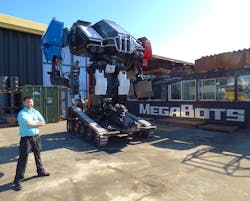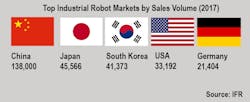No country is even close to America when it comes to churning out cinematic thrillers depicting the robot apocalypse, introducing a steady supply of cyborgs, replicants, androids. Making actual industrial robots—the ones that perform our boring, repetitive tasks in factories and warehouses—well, that’s a different story altogether. It’s an area America is sorely lacking in, and if serious action isn’t taken soon, it could lead to a bleak future for U.S. manufacturing.
The International Federation of Robotics (IFR) estimates robot sales were about $40 billion in 2017 and that the market for both industrial and non-industrial (such as medical, consumer, agricultural) will grow to more than $550 billion by 2025. These machines generally supplant human workers in jobs with little complexity and high repeatability, from material handling and assembly to welding and machining. In the next ten years, they may soon be performing more medical tasks, farming work and maybe even assisting at daycares.
That’s not the bleak part. What’s troubling is that America’s workforce and manufacturing infrastructure don’t seem adequately prepared for the unprecedented disruption. As detailed in Part 1, the Automation Readiness Index released in 2018 had eight major economies better prepared than America to face the robot disruption in regards to training, education and governmental policies.
There’s no doubt America has amazing individual roboticists, varying in age, gender, and ethnicity. I’ve met many of them, from Baby Boomers working on soft robots to Millennials who built giant fighting ones.
Those make for good story material, but we should be past profiling the gifted few and immersed in the mundane grind of educating an army of workers who can design, build and maintain robots. It’s like every other country gets that this is a team sport except us. As a Clevelander, I can tell you it was really fun to watch LeBron James every night, though the city hoisted only one championship. It was the best championship ever, of course, but still only one. And our city has moved onto the resurging Browns as if the Cavaliers never existed.
Our manufacturing base could suffer the same fate. In 20 years, the factories and plants currently driving record unemployment and pushing the stock market higher will be widely run by those robots. If we don’t have the people to install and fix them, then those plants will suffer downtime, poor quality and lower output. Customers will go elsewhere, likely abroad to a nation that has embraced automation and has lower prices and consistent production. America will slowly fade into obscurity, but at least we’ll have our 20th Terminator reboot.
From First to Fourth
The frustrating thing is that America had a big head start by making and using the first industrial robot—Unimate, commercialized by the visionary Joseph F. Engelberger and used at a General Motors plant in New Jersey. Fifty-eight years after the Unimate launched, the U.S. doesn't have a single major homegrown industrial robot manufacturer to nourish a robust robo-centric ecosystem.
The IFR says Japan is the robot-making market leader, producing 56% of all industrial robots, while European-based manufacturers such as Universal Robots and KUKA, may have the inside track on making the next big thing in automation, collaborative robots, which could account for a third of the market by 2025.
Meanwhile, China, which in 2017 bought 138,000 units (23% higher than the U.S. and Europe combined), is developing its own solid foundation that could dwarf the rest of the world. A recent Oxford Economics report says China will have 14 million robots in the workforce by 2030, or 70% of the projected global number of 20 million.
"I am scared of the effort that China and our European colleagues are putting into robots compared to us," says Howie Choset, professor of robotics at Carnegie Mellon University.
"If you go to a robotics tradeshow in China, it's overwhelming as to how many industrial robot systems they’re creating at pretty low prices," Choset says. "We have nothing."
We have a little, actually. Just as car companies such as Toyota or BMW have plants here to reach the North American customer base, Swiss-based ABB manufactures some in Auburn Hills, Mich., while Japanese-based Yaskawa Motoman produces industrial robots out of Miamisburg, Ohio.
“We are now closer to our customers than any other major robot manufacturer, allowing us to better understand their most pressing challenges and to deliver far better lead times than ever before,” says Joe Chudy, U.S. general manager of ABB Robotics.
Currently, the Auburn Hills plant fulfills 75% of North American demand, according to ABB, which also has production in Shanghai and Västerås, Sweden. The U.S. is one of the company’s largest market.
“The new manufacturing presence has reduced the standard product delivery times in North America from the 15 weeks it was before the factory, to six weeks for orders of 15 units or less,” Chudy adds.
When you consider the millions and millions of robots expected to be made, a few plants scattered throughout the Midwest are basically nothing.
Herein lies the critical issue: there’s a bourgeoning new mega-industry, on the magnitude of the automotive market, and America is largely on the outside looking in.
The reason all the bot-positive inventors and investors in the automation industry aren’t doomsday prepping right now is that they assume new jobs will be created, as these robots need to be built installed and maintained. And many other new jobs will pop up that we can’t predict.
That’s how it’s always gone with new technology in the past, so why not this time?
The problem is each of these new jobs does not have equal value. Manufacturing jobs have the highest multiplier effect, creating 3.4 other support jobs, according to MAPI. And manufacturers support schools and universities and offer internships to train the next generation. KUKA does offer robot training at Greenville Tech in South Carolina to support the nearby BMW plant, but do you think the more robust education is near one of its German locations (which take advantage of Germany’s apprentice program) or in a community college classroom, albeit a very high-tech one?
So those jobs that Choset says we don’t have, those are the ones we really ought to be investing in, and they will also perpetuate a constant pipeline of even more. If we don’t find some way to manufacture high volumes of robots in the next few decades, the country may more closely resemble one of those sci-fi hellscapes Hollywood imagines robots would create. Only this time, it would be our own collective lethargy that’s to blame.
Getting in the Game
Even in dystopian movies, you have a glimmer of hope, a longshot hero, from John Connor standing up to Skynet to the Avengers facing Ultron.
This task will need thousands of heroes, though they will likely be researchers clad in button-down shirts and comfortable sneakers, not ripped up tank tops or battle armor.
Choset is the prototypical soldier for this kind of war. Named a Joseph F. Engelberger Award winner for his work in education at Automate 2019, he has done his part by co-founding three robot companies. One company is trying to bring his slithering snakebot to market. It has been used in search and rescue missions and could be scaled down for surgical applications.
He also helped launch the Advanced Robotics for Manufacturing (ARM) Institute, bent on making to easier for robot companies to work with each other and the rest of the manufacturing industry. There are hundreds of these exciting robot startups flourishing from Boston Harbor to San Francisco Bay, up north in Detroit to Austin in the south. As to why this hasn’t translated to large scale industrial robot manufacturing yet, Choset doesn’t have an answer. However, Choset mentions the “staggering” research investments other countries make in automation.
As part of Germany’s High-Tech Strategy, the government is providing €70 million ($78 million) in annual non-refundable cash grants from 2016-2020. Europe’s manufacturing powerhouse also has the Fraunhofer Institute for Factory Operation and Automation, which counts among its innovations a floor sensing system to allow humans to work closer to high-payload robots. (There are dozens of more examples, though that one stood out.)
There is still reason optimism, as we have all the pieces we need. It’s just a matter of putting them together.
Some Assembly Required
“Our basic research is the best in the world,” Choset says. “Where we fall apart is translating that from basic research to real innovation. We could do great things if we figured out how to translate our basic ideas to practice."
Choset believes there are four primary areas to focus on to strengthen the American robotics industry:
1. Increase American productivity to compete with low-income nations
2. Lower the barrier to adoption so SMEs can embrace automation, chiefly through reducing the cost of robot integration, which can be four to five times the cost of the robot
3. Ensure automation creates wealth and job creation
4. Assert U.S. leadership in robot manufacturing
These are all easier said than done, requiring public-private partnerships and a lot of innovation and outreach. Those foreign manufacturers ABB and Yaskawa Motoman have teamed with their local communities.
ABB offers robotics training to anyone who wants it at their Auburn Hills facility, even reskilling former automotive workers. They also donate licenses to their offline, simulation software, RobotStudio, to high schools, colleges and universities. A reduced-cost STEM certificate program also comes with a small 6-axis industrial robot with an IRC5 robot controller to strengthen practical skills as well.
“The intention is to expose as many students as possible to robotics, with the goal that those who are most interested will pursue additional robotic training,” Chudy says.
Choset did hint at a solution to help SMEs embrace automation:
"Most install systems should be as simple as downloading an app on your smartphone," he said. "I'd like to see development go in that general direction."
This is touching on the low-code/no-code movement, which is more drag-and-drop than manually typing in code chains. It the same concept blogging sites adopted a decade or so ago to help everyone post their chicken marsala recipe/life story online without knowing HTML.
Gartner predicts by 2024, low-code applications will account for nearly two out of every three application development activities.
The power of allowing the SME market to join the robot revolution cannot be understated. They comprise nearly 99% of the manufacturing sector, and if they can afford these productivity tools, they could keep pace with or potentially beat foreign competition.
"ABB is also seeing large growth in SMEs, which represent a market of great potential," Chudy says. "Technology advances that make robots easier to use is opening the market to new industries and new users, especially small and medium enterprises (SME) who form the backbone of many global economies."
Higher domestic demand would also make it feasible for more small robot manufacturers to open up. Instead of a Big Three, where one CEO can affect thousands of workers, America would have thousands of small “bot shops,” each catering to different needs of various industries and consumers. Maybe there could be off-the-shelf parts integrators can pick up at a high-tech Home Depot to build custom six-axis arms like a contactor would to remodel a kitchen. A Canadian company, EZ-Robot, already has an educational version like this.
And in manufacturing, it doesn’t matter who made what first or what nation is on top now.
“You don’t need the first and best, but the most repeatable,” Choset says.
And Choset has one final piece of advice about letting go of the past and seizing the present that will prevent a dark economic future: “Work on what the next industrial robot is going to look like and invest smartly and heavily into it.”









